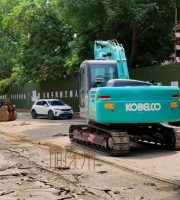Up to now, prefabricated buildings account for 30% of new buildings.
The prospect of green, environment-friendly and resource-saving prefabricated buildings can be expected that after a steel bar is sent to the assembly building assembly line, it will be bent and shaped.
On the spot, they are hoisting prefabricated PC component partition boards for prefabricated buildings.
Since 2018, Guiyang has formulated goals and policies related to the promotion of prefabricated building development, proposed that prefabricated buildings of new projects will account for 40% of new buildings this year, and made it clear that prefabricated buildings will account for 80% by 2025.
Our province has made it clear that by the end of 2025, the proportion of prefabricated buildings in the newly built building area in the province will reach 30%.
It is to assemble the “parts” of the house like “building blocks” to avoid some common quality problems and human errors caused by on-site construction technology.
The production line workers of CSCEC Guizhou Branch, a model residential building in a residential district that is adopting the prefabricated construction method, are in the PC factory to produce prefabricated PC components for the construction market.
Xie Xiang, the chief engineer of CSCEC Western Technology Co., Ltd., has learned: “Traditional construction sites often give people the impression that dust is flying and garbage is everywhere, while prefabricated buildings are more economical, green, intelligent and beautiful.
Prefabricated buildings refer to prefabricated components such as walls and laminated plates required by buildings, It is a new type of green construction mode, which is produced according to the standard in the enterprise workshop, assembled the prefabricated parts on the construction site, and realized standardized design, factory production, assembly construction, information management, and intelligent application.
Under the background of “double carbon” (carbon peak, carbon neutral), the problems of high energy consumption, heavy pollution, on-site pouring, and difficult to overcome quality “common problems” in the traditional construction industry force the construction industry to rely on scientific and technological innovation to seek green and low-carbon transformation.
Developers’ construction and installation costs account for a high proportion.
In the proposal, Wei Huairui pointed out that the comprehensive advantages of prefabricated buildings can only be brought into play by strengthening the promotion of EPC from the top-level design, improving and optimizing the industrial chain, making all links organically connected, and cultivating prefabricated building industry clusters in the city.
Because of its standardized prefabrication, modular components, simple construction and other characteristics, prefabricated buildings have the advantages of energy conservation, emission reduction, and green development, and become an important direction for the transformation and upgrading of the construction industry.
After binding, pouring, demoulding and other processes, it will turn into prefabricated components such as balcony, road, stair, and then be sent to the site to be assembled into buildings like “building blocks”……
However, Guiyang is not systematic in the training of prefabricated building design management talents and construction workers, which restricts the development of the industry.
The proposal also points out that, on the one hand, high cost increment restricts development.
On the same day, three prefabricated rural schools in Gaopo Township, namely the Central Complete Primary School, Wuzhai Primary School and Wuzhai Kindergarten, were officially put into use, marking the successful landing of the first batch of prefabricated green building demonstration rural schools in Guizhou Province.
Guiyang is a national demonstration city of prefabricated buildings.
It is gratifying to note that with the completion of four prefabricated rural schools with the highest altitude in Guiyang, namely, Huaxi No.
The construction process of prefabricated buildings has changed the traditional on-site pouring mode.
” At present, Guizhou has successively built several prefabricated PC plants in Huaxi, Xifeng, Qingzhen and Liupanshui, and the prefabricated building technology and prefabricated components have been widely promoted and implemented in public buildings, housing construction, industrial plants, schools, municipal facilities and other construction fields and project sites.
The lack of talents, the imperfect industrial chain and the urgent need to break through the bottleneck of development At present, prefabricated buildings have attracted much attention, but they also encounter some difficulties in the development process.
At the same time, the prefabricated building design and construction have high requirements for the comprehensive quality of talents.
At present, more than 20 prefabricated building projects have been contracted, with a construction area of 1.5 million square meters.
Take the four prefabricated green building demonstration rural school projects undertaken by us as an example, to reduce construction waste by 70%, save wood by 60%, save cement mortar by 55%, reduce water consumption by 25%, and reduce carbon emissions by more than 40% in the whole life cycle is expected to achieve” peak carbon “and” carbon “in the construction industry The important technical path of neutralization.
In 2018, the first prefabricated building demonstration base in Guizhou Province, the CSCEC Guizhou Green Building Industrial Park project, landed in Huaxi Yanlou Industrial Park, which is also the largest and most complete prefabricated factory in Southwest China.
Developers and the market are more sensitive to incremental costs; On the other hand, the industrial chain is not perfect, and the equipment manufacturing, integrated decoration, logistics transportation, vocational training and other chains are blank, which affects the overall promotion.
2 Middle School and Gaopo District in Guiyang, CSCEC Science and Technology Group, as the leading prefabricated building enterprise in Guizhou Province, has provided a vivid model for the prefabricated building schools in the city, a number of replicable and promotable construction experiences, and gradually let people see the green and bright future of prefabricated building, Boost the potential of green, sustainable and high-quality development in Guizhou during the “Fourteenth Five Year Plan”..
Recently, more than 1000 primary school students and 40 teachers from Gaopo Township, Huaxi District, Guiyang City entered the spacious and bright new school Yunding Primary School cheerfully, This is a prefabricated green building demonstration rural school.
The development of prefabricated buildings is a major change in the way of construction.
At the “Two Sessions” of Guiyang this year, Wei Huairui, deputy chairman (concurrently) of the Guiyang Municipal Party Committee of the Agricultural and Labour Party and deputy director (associate professor) of the Industrial Development Service Center of Gui’an New Area, presented the proposal “Suggestions on Vigorously Developing the Fabricated Building Industry in Our City under the Background of” Double Carbon “.
The cost of prefabricated buildings is about 200-300 yuan/square meter higher than that of traditional buildings, accounting for a high proportion of house prices.


